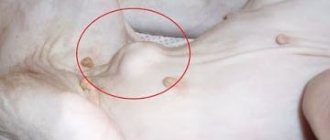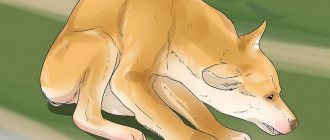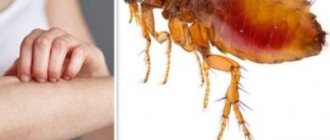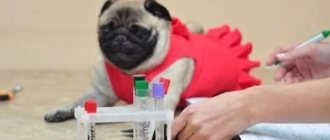Many people get pets and subsequently find reliable and loyal friends. Animals, like people, suffer from various diseases. Quite often, they are diagnosed with diseases of the digestive tract, respiratory tract and various seals. Of course, pets need care, which includes scheduled and timely examination. Diagnostic measures make it possible to detect various seals, lumps and tumors, hematomas, which are quite dangerous. They typically form on the face, ears, paws and nose. This article will be useful to those who have a devoted friend in the form of a dog.
Causes of the disease
In animals, the tissues of the middle, external or internal swell. The reason for this and the diagnosis can only be established by a specialist, so at the first symptoms you should consult a veterinarian.
Doctors say the following are the main causes of ear swelling in dogs:
- foreign body in the ear canal;
- water in the ear;
- growths;
- abscess;
- allergy;
- hematoma;
- otitis.
The main danger of a dog having swollen ears is the risk of life-threatening complications for the animal. In particular, this complication is called inflammation of the lining of the brain. Large tissue swelling can lead to ruptured eardrums and deafness.
Symptoms of ear diseases
Regardless of the causes of ear tissue tumors, the problem is quite simply determined by the corresponding symptoms. It will not be difficult for an attentive owner to notice the swelling on his own. After this, you need to show your pet to a specialist.
The main symptoms that a dog has a swollen ear:
- the pet's mood has changed;
- the animal constantly tilts its head to the side;
- the dog tries to press its ear to its head;
- on the side of the damaged ear, the animal’s neck is in tension;
- the pet shakes its head sharply from side to side;
- the dog is extremely restless;
- the pet refuses food and sleep;
- purulent discharge with an unpleasant odor is observed in the ear canal.
If at least three of the above symptoms are present, you should carefully examine your dog’s ears and, if necessary, contact a veterinarian.
Otitis
One of the reasons why a dog's ears are swollen is swelling of the mucous membrane of the auditory canal as a result of inflammation - otitis, the occurrence of which is provoked by ear mites entering the auditory organ.
Another cause of inflammation is irregular care of your pet’s ears, during which they are cleaned. An infection in the ear canal can also cause swelling. The reason for this, as a rule, is insufficient care of the pet's ears.
With otitis media, purulent discharge with a rather unpleasant odor begins to form.
Using special equipment, the doctor can see the ear mite in the ear canal, which is the causative agent of the disease.
Otitis has several varieties, which only a specialist can identify and prescribe treatment for. Typically, veterinarians prescribe rinsing the ear holes with saline solution and a course of antibiotics as therapy.
The following symptoms of otitis media exist:
- the animal often scratches its ear, tilts its head to one side or shakes it;
- The dog's ear is swollen, there is fluid inside;
- the pet does not tolerate the examination well, whines and tries to escape from the hands;
- the skin looks inflamed;
- There is an unpleasant odor coming from the ear canal.
Discharge from the ears can form crusts, which must first be softened by briefly smearing with vegetable oil, and then carefully removed with a cotton swab soaked in hydrogen peroxide.
Type of tumors
In the event that a dog begins an inflammatory process, first of all, it is necessary to find out what it is.
Hematoma
A hematoma is a specific blood compaction resulting from hemorrhage under the skin of the ear. In most cases, hematoma occurs in representatives with drooping ears. The cause of hematoma formation is represented by mechanical damage to the ear. This kind of compaction occurs due to damage to blood vessels or through excess fluid. The formations have a soft texture and variable shape.
During a medical examination, a soft and hot lump is detected. The animal experiences itching, so it constantly scratches the sore ear. This action causes the wound to bleed. In case of a hematoma, it is necessary to apply a cold compress, fixing it tightly. If the compress does not give a positive trend, then the veterinarian opens the dog’s ear tumor and removes the blood. The open wound is washed with hydrogen peroxide and a bandage is applied.
Otitis
The ear may become swollen due to an inflammatory process occurring in the outer part of the ear canal. In some cases, otitis media is characterized by purulent discharge. The etiology of this disease is represented by inappropriate care of the animal or infection. The causative agent of otitis is ear mites.
A mite in the ear can cause severe inflammation and cause hearing loss.
Otitis media can be caused by a polyp or tumor in the ear canal. If the disease affects the middle and inner ear, then the pet is characterized by loss of the ability to navigate in space.
A sick dog's head is tilted to one side. The animal constantly scratches its inflamed ear. When pressing on a sore spot, the dog experiences pain and tries to escape.
As for the treatment and complications of this disease, only a veterinarian can clarify. In order to prevent otitis media, experts recommend rinsing the animal’s ears with hydrogen peroxide once every 14 days. After this procedure, the ears must be wiped dry. Such manipulations can be carried out after bathing your pet.
Growths
Perhaps the tumor is a common wart or papilloma. Such formations more often occur in representatives of the smooth-haired breed. The real reason for their occurrence is unknown. However, a wart or papilloma is a consequence of a viral infection. As for the appearance of the bump, it looks like a growth with a dark tint. They do not cause pain in the dog, however, papilloma is characterized by itching. Scratching will lead to infection. Therefore, it is recommended to visit a veterinarian.
Abscess
A process such as suppuration can be triggered by a bacterial infection. An abscess is a tumor containing pus. Very often, an abscess occurs at the site of a wound or bite. Symptoms of an abscess include high fever and pain in the area of suppuration. The abscess may swell and pus will get inside.
Allergy
Very often, ear problems are allergic in nature. This nature is characterized by various manifestations, in particular pus. As a rule, this phenomenon is accompanied by severe itching. In case of an allergic reaction, it is important to detect the allergen and avoid contact with it. A simple bite from insects such as bees or wasps can also cause ear swelling.
Foreign objects
A dog's ear can also become swollen due to water, foreign objects and insects getting into it. If an insect gets into the ear, then to remove it you need to drip 10 drops of vegetable oil.
As for foreign objects, plant components occupy the first place. Individual cereal seeds are very dangerous due to their coating. With each movement, the ingested seed is immersed deep into the ear canal.
If help is not provided in time, the animal may lose its hearing.
Hematoma
An ear hematoma occurs due to mechanical damage to tissue or as a complication of infectious diseases. This lump is an accumulation of blood and lymph fluid under the skin.
To stimulate the resorption of blood accumulation, daily, tightly bandaged cold compresses are usually used. In more complex cases, when the dog’s ear is swollen, your veterinarian will tell you what to do. Most likely, surgery will be performed in a clinical setting to remove the accumulated fluid and blood clot.
Hematoma can be identified by the following signs:
- a tumor located inside or outside the auricle is easily palpable and hot to the touch;
- the pet systematically shakes its head and scratches its ear with its paws;
- scratching causes wounds to form that begin to bleed;
- Sometimes the auricle can tear.
Diagnosis of ear cancer in dogs
It is not possible to determine with certainty whether ear lumps are benign or malignant through medical observation or physical examination alone.
The final diagnosis of the tests is made only based on the results of blood and urine, as well as a biopsy.
Tumors can be examined using an otoscope; this examination usually requires anesthesia.
A CT scan or MRI may also be suggested to determine the extent of the tumor(s). A biopsy may be performed during an otoscopic examination or surgery.
A biopsy of the lymph nodes, as well as a chest x-ray, is done for malignant tumors to check for the presence of metastases.
Allergies, growths, abscess
Dogs' ears can also become swollen for other reasons.
The following cases often occur:
- Allergy. If it is determined that the cause of swelling is an allergic reaction, antihistamines are instilled into the ear. The source causing this reaction should be identified and the animal’s contact with it should be completely eliminated. If an insect bites you, you need to wait for the medicine to take effect. In case of purulent discharge, the ear canal is treated with an antiseptic.
- Growths. A common occurrence in dogs are warts and papillomas in the ear. Such formations appear, regardless of age, as a result of the penetration of a viral infection. They cause inflammation and then abscess of the mucous membranes of the ears. If your dog's ears are swollen due to growths, only a veterinarian can decide what to do. In case of severe itching, wounds from scratching and the risk of infection, a specialist may decide to remove the formations.
- Abscess. This is the name given to a purulent tumor that occurs at the site of a bite or wound when pathogenic bacteria enter there. In a clinical setting, the suppuration is opened and treated with antiseptic agents until healing.
Foreign objects
Another cause of swelling in a pet’s ear is small objects or insects getting into the ear canal.
A foreign body can get into a dog’s ear canal while playing with children: they can insert small objects into the ear - peas, beads, balls. Since they cause discomfort to the animal, this is quite easy to notice: the dog shakes its head, trying to free itself from the discomfort. The same thing happens when it gets into the ear of an insect.
Remove the resulting inflammation with a few drops of sterilized vegetable oil. After instillation into the ear, the swelling will subside and it will be possible to remove the foreign object. If you can’t correct the situation on your own and the dog’s ear is swollen inside, the veterinarian will figure out what to do.
Water got into my ear
Often, while bathing or swimming, water gets into the dog's ears. As a rule, the animal shakes its head, freeing the ears from fluid. But sometimes this does not happen and inflammation of the middle ear occurs, which can be facilitated by a draft. If your dog's ears become swollen as a result, you should contact your veterinarian for advice.
The problem is relevant for dog breeds with cropped ears.
To prevent inflammation, you need to:
- bathe your pet with caution;
- Before water procedures, insert cotton swabs lubricated with Vaseline into the ear canals;
- After bathing, turn the animal’s head to the side, shake it slightly so that all the water flows out, and wipe the ear canal dry with a stick with cotton wool at the end.
How to help a dog with otitis: effective treatment methods
Domestic dog breeders often encounter this problem when the pet often shakes its head. It’s okay if this is a consequence of dirt or dust getting into the ears, but it’s much worse if the cause is otitis media. Otitis in a dog - how to treat it at home, what are the symptoms and causes, you can see the photo below.
Otitis media is a fairly common disease among pets. This disease is an inflammation of the external auditory canal; veterinarians encounter this problem in animals every day.
It is possible to detect fungal otitis in dogs at home, but self-medication is not recommended.
The specialist must carry out a complete examination of the animal before prescribing a specific treatment.
Purulent ear otitis is often caused by parasites that have “settled” in the ear of a pet. Ear mites, as practice shows, do not often bother domestic dogs; they are usually typical for outdoor dogs. As a rule, this disease manifests itself as a result of the appearance of foreign bodies in the ear, these can be tumors or wounds.
Symptoms of the disease
As stated above, detecting otitis media at home is not so difficult; all you need to do is look in the dog’s ear. If otitis is allergic, allergic redness will be clearly visible on the ear canal. And there may be a clear discharge in the ears. Actually, that’s why the animal’s ear will constantly hurt.
Let's move on to the main symptoms characteristic of this disease:
- the main symptom is the pet’s anxiety - the dog will behave unnaturally, constantly looking for a new place;
- if you try to examine the animal’s ear, this can be problematic, since the dog will begin to whine pitifully, it will be very painful for him;
- one of the main symptoms is that the animal will constantly shake its head;
- Also, with otitis, dogs often walk with their heads tilted to the left or right, this symptom indicates the manifestation of otitis in a particular ear;
- Another symptom is the appearance of an unconventional odor in the ear area;
- otitis media causes the need to scratch the ears on household objects; a tumor may form on the shell inside the ear, especially if there is a lot of wax in the ear;
- A symptom of purulent otitis is purulent discharge that falls out when the pet shakes its ears.
Any otitis, be it purulent or malassezia, will be accompanied by the presence of dirt in the ears. One way or another, the breeder must understand that the first priority is to remove dirt that does not allow the medicinal substance to penetrate and act. Therefore, treatment with drops is carried out strictly after high-quality cleaning of the ear from wax and accumulated exudate.
Causes of the disease
To know how to cure a dog, you need to understand the reasons why this disease manifests itself in animals.
https://www.youtube.com/watch?v=aolwlUTFgKs
There are several reasons, all of them are discussed below:
- Formation of an ear tumor. If a dog scratches its ears intensively, this may indicate the formation of a tumor that appears directly in the ear canal or on the shell. Over time, the neoplasm may simply block the entire passage, and therefore oxygen will not be able to enter the ears. This may cause the shell to swell and cause blood to bleed from the ear. It is not possible to cure the tumor on your own; the only way out is treatment from a specialist. Most likely, the only way to get rid of the tumor is through surgery.
- Parasites. One of the most common reasons for the need to treat an illness is parasites, namely ticks. If no one takes care of the dog’s ears and they are constantly dirty, then this can serve as a good breeding ground for ticks. The parasites themselves feed on sulfur, and their size is so tiny that it is impossible to independently determine their presence. Infection with the parasite can occur after contact with a sick dog or with objects on the street. As practice shows, in some cases cats become carriers of ticks, especially those that often go outside. In most cases, due to mites, both ears of the animal itch; if the problem is not treated in time, this can cause the appearance of ear pus.
- Allergy. As mentioned above, the disease may be allergic in nature, that is, caused by a specific pathogen. For example, when wax accumulates in a pet's ears and is not removed by the owner, this environment is favorable for fungus. As a rule, in this case, redness forms on the ears, as the dog constantly scratches his ears. In some cases, wounds may even form.
- Foreign body. Another common cause is foreign bodies getting into the passages. It must be borne in mind that many breeders are faced with this disease precisely for this reason. If a dog walks along the street, the same insects can serve as an irritant to the disease. Of course, not every insect that enters an animal’s ear can cause an allergic reaction, but there is a possibility of this happening. Especially if during a walk the animal likes to rummage through the foliage. As a rule, in this case the disease is unilateral, since it usually affects one ear. The breeder may notice that discharge accumulates in the ear, and blood may drip from it.
- In some cases, overgrowing of the shell may be the reason for the need for treatment. In practice, this problem is most relevant for individuals characterized by folding on the body. For example, shell overgrowth is usually typical for bulldogs and sharpeis, as well as other similar breeds. The ear canal may be blocked due to the characteristics of a certain breed. Treatment in this case is also carried out strictly under the supervision of a veterinarian.
- Cold. Otitis media can also occur in case of a cold (the pet’s ears can get blown in a draft or in a car).
- Water getting into the ear canal.
How to treat disease in domestic dogs?
What to do and how to treat a disease in a pet? The main methods of treating this disease are given below. It is necessary to choose drops or antibiotics for treatment depending on what type of disease is observed in the dog. In any case, before treating your dog, you should consult with a specialist (video author: Advice from a veterinarian, Lina Vet).
So, the treatment methods are presented below:
- Diet table. Treatment of an allergic type of illness is usually carried out through the use of a hypoallergenic diet. Usually the diet is for the next three months. In some cases, medications may be prescribed to help relieve swelling and itching.
- Drug treatment, surgery. As you can see from the photo, the purulent type of the disease is quite dangerous for the animal. If the case is really advanced, then the problems can be serious, often doctors have to perform surgery in order to help the dog. Subsequently, the sinks may be treated with medications - chlorhexedine and hydrogen, which will remove all dirt. If your pet's pain is really severe, the specialist may also prescribe antibiotics. In some cases, the veterinarian may also prescribe a “human” medicine - Otosporin or something similar.
- Consultation with a veterinarian.
If there are parasites in your pet's ears, you should also consult a specialist. Drops may well be used to rid the animal of the problem. But before prescribing certain drops, the doctor will need to accurately determine the type of pathogen. Usually drops are prescribed for a certain period of time. The use of drops is also allowed during the prophylactic period. Fungus formation is also a problem. Of course, in this case you should not self-medicate; first of all, the animal should be taken to a veterinarian for examination. Specialists, as a rule, in such cases use treatment of contaminated areas using phosphoric acid. As a rule, drops are prescribed by doctors if the disease is seasonal. Usually drops are prescribed along with antibiotics, which will reduce pain. Use is possible together with a special Otifri lotion or something similar.
Prevention
As for prevention, every dog breeder should carry it out. If your pet's fur is too long, then it needs to be constantly trimmed around the ears. Under no circumstances should the passage itself be damaged, so this must be done as carefully as possible.
Remove wax from time to time and make sure there is no unpleasant odor coming from your dog’s ears. It is also better to avoid moisture. Passages should be treated with solutions specially designed for this purpose. After treatment, the ears should be wiped dry.
In any case, if you notice any symptoms appearing, you should immediately contact your veterinarian. Otherwise, the consequences could be dire.
Diagnostics and preventive measures
To examine the animal and understand why the dog’s ears are swollen, veterinarians use special equipment - an otoscope. The instrument allows you to examine the ear canal from the inside for the presence of foreign objects, swelling, polyps, and inflammation. This makes it possible to accurately diagnose and determine the correct treatment.
In order to avoid ear problems in dogs, you should adhere to the following preventive measures:
- undergo routine examinations with a veterinarian in a timely manner;
- systematically carefully carry out hygienic procedures for the animal, especially when it comes to cleaning the ear canals and the inner surface of the ears;
- regularly engage in grooming, trimming excess hair in the ear area;
- do not allow the dog to become overcooled or in a draft;
- Pay close attention to your pet, paying attention to unusual or restless behavior.
It should be remembered that animals need increased attention from their owners. Having noticed the first signs of the disease, a person needs to contact a veterinarian’s office for advice as soon as possible. Otherwise, due to delays in the visit, there is a high probability of the disease progressing and the development of severe complications that can lead not only to pain, but also to the dog’s hearing loss.
Diagnosis of the disease
In order to notice and defeat the disease in time, it is not enough to simply observe your pet. Any change in behavior or physical signs should prompt immediate veterinary attention. How can the doctor help? He carefully examines the animal and, perhaps, notices signs that have escaped even the owner’s attentive gaze.
Secondly, he will prescribe the necessary tests. First, the standard ones - general and biochemical, and then, if changes in certain indicators are noticed, special ones - to identify tumor markers confirming the presence of cancer cells.
Diagnosing cancer is a rather complex process, therefore, in addition to tests, the doctor will conduct many different examinations - from ultrasound and fluorography to gastroscopy and MRI. If you suspect breast cancer, your doctor will suggest you undergo a mammogram, a special X-ray of the breast that shows the presence of a cancerous tumor at an early stage.
When a tumor is detected, the doctor will take a small piece of tissue (puncture) and send it for cell analysis. This will help determine whether a neoplasm is benign or malignant, as well as the stage of development of the disease.










